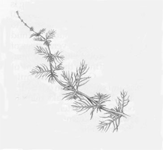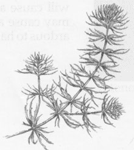Aquatic plants are a necessary component of a pond; they contribute oxygen to the water, provide cover, food, and nesting and nursery habitat for aquatic animals, and protect the shoreline from erosion. However, a common problem for pond owners is excessive vegetative growth. Too much vegetation in a pond is unsightly and can prevent the recreational uses of the pond for which it was intended. Moreover, excess pond vegetation is an indicator of an unbalanced ecosystem where too many nutrients are entering the water.
Controlling Nutrients
As the weather warms, conditions for aquatic vegetation to grow become ideal. In the summer months, inputs of nitrogen and phosphorus stimulate plant growth. Then as aquatic plants die and decompose, they release stored nutrients back into the water and use up precious dissolved oxygen. This cycle of growth, death and decay results in overabundant pond vegetation, deteriorating water quality and, if oxygen levels are sufficiently depleted, can cause die offs within the pond’s fish community.
The best way to manage overly prolific aquatic vegetation in your pond is to control nutrient runoff at its source:
- Limit the use of fertilizers,
- Manage runoff from horse pastures and manure piles properly,
- Ensure proper maintenance of septic systems on lands surrounding and draining to the pond,
- Plant and maintain a 2-3 foot wide vegetated buffer of native trees, shrubs and grasses around your pond to help filter runoff and reduce nitrogen and phosphorus inputs.
Identify Your Problem Pond Plants
When these initial steps aren’t sufficient to address the problem, nutrient management can be coupled with chemical, biological or physical controls that directly reduce the number of plants in the pond. Before choosing your plan of attack, however, you should identify which plant or plants are the problem in your pond. Pond plants vary widely. There are floating species like duckweed or filamentous algae, submergent species such as hydrilla that grow within the water column, and strongly-rooted “emergent” species like the cattail. Knowing which type of aquatic plant you are dealing with, as well as something about its characteristics, will help you decide how to address your vegetation problem.

Hydrilla verticillata

European milfoil
Myriophyllum spicatum

Coontail
Ceratophyllum demersum
Manual Removal
Submergent aquatic plants such as hydrilla (Hydrilla verticillata), coontail (Ceratophyllum demersum), Eurasian milfoil (Myriophyllum spicatum) and curly-leaf pondweed (Potamogeton crispus) are particularly likely to form dense masses of vegetation and to become problem plants within the pond. These plants reproduce readily from plant fragments or regenerate from root systems left intact in the bottom of the pond. For this reason, mechanical controls, including the use of a pond rake or aquatic harvester, are generally not effective in removing significant infestations of these species. These methods are also very labor intensive, and often leave enough plant material behind for the plant colony to regenerate. However, to eradicate small populations of these problem weeds, physical hand removal of the entire plant can be effective. For rooted submergent aquatic plants such as the curly-leaf pondweed, measures such as dredging and deepening of the pond to reduce light penetration or, in a small pond, installation of a pond bottom liner, can also control excessive plant growth.
Herbicides
Are herbicides an option? Applying a chemical control such as an herbicide provides a quick and dirty, but not necessarily the best, solution for dealing with prolific submergent aquatic plants. If an infestation is caught and treated early, herbicides can be the most efficient way to control aquatic vegetation. Generally, however, chemical treatments simply compound an aquatic vegetation problem. After the herbicide is applied, dead plant material settles in the pond where it decays, releasing additional nutrients and jump starting the next cycle of plant growth. The result of chemical treatment is typically a never-ending cycle of increasingly frequent, and increasingly expensive, applications. If you do choose to treat your pond with herbicide, it’s best to hire a certified pesticide applicator to prescribe the appropriate herbicide for your problem, accurately determine the rate and timing of the application, and apply the chemical safely.
Biological Controls
For submergent aquatic vegetation, biological controls, specifically the introduction of triploid (sterile) grass carp into the pond, are much more effective than herbicides in the long-term. Triploid Chinese grass carp (Ctenopharyngodon idella) are plant-eating fish that have been genetically altered to have 50 percent more chromosomes than normal, making them sterile. They won’t reproduce in the pond and happily eat soft tissue pond plants such as hydrilla and coontail. In fact, they eat up to 40 percent of their body weight every day during the summer months. The typical stocking rate for this fish varies depending upon the seriousness of the pond plant problem and the type of plant targeted for control. As a general rule, Virginia Cooperative Extension recommends stocking 12 large fish (9-12 inches in size), per surface acre of vegetation. A permit from the Virginia Department of Game and Inland Fisheries (VDGIF) is required to purchase and stock these fish in your pond. This department also maintains a list of state-certified hatcheries where sterile grass carp can be purchased. For more information contact VDGIF’s Triploid Grass Carp Program at 804-367-6913, TTY 711.
There are, of course, drawbacks to the use of triploid grass carp in your pond. For one thing, it can take some time to see a reduction in the population of unwanted plants. Additionally, triploid grass carp are indiscriminate eaters and will eat any soft vegetation available. Because these fish refrain from eating plant species like duckweed or cattails, over time these species may grow in population in your pond. For these reasons, it is important to closely monitor pond vegetation conditions and potentially use chemical, physical or even other biological measures, such as bio-dredging, to supplement the use of triploid carp in your pond.
Bio-dredging
Bio-dredging is an innovative biological control measure that gets at the heart of the problem as far as excess aquatic vegetation is concerned, by removing the nutrients feeding the plants. In bio-dredging, large numbers of bacteria are introduced into the pond to feast on nutrients adhering to pond sediments. The bacteria also feed on decomposing plant material, aiding in the decay process and removing nutrients from the pond before they become available for uptake by pond plants. As the pond ecosystem recovers and water quality improves, the bacteria are deprived of their food source and die back to normal levels. Bio-dredging is available primarily through private pond management companies and can be expensive, particularly if repeated applications are required. However, the technique can be extremely effective as a preventative measure or to maintain a healthy pond ecosystem, especially in situations where nutrient contributions cannot be adequately controlled.
Reducing excess pond vegetation can require a long-term investment and some experimentation on your part, particularly if you have an ongoing nutrient management problem. However, a variety of biological, chemical and physical techniques are available to help you control excess pond vegetation. The controls described here should get you started towards managing your excess vegetation and creating a healthier pond ecosystem for you and for wildlife.
Need to identify an aquatic plant in your pond? Contact the Fairfax County office of the Virginia Cooperative Extension Service at 703-324-5369, TTY 711 or the Northern Virginia Soil and Water Conservation District at 703-324-1460, TTY 711.
Coontail and Eurasian milfoil illustrations by Rick Hill, Kentucky Department of Fish and Wildlife Resources.
Hydrilla illustration by Pels.

